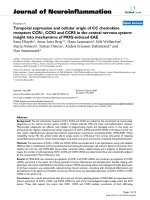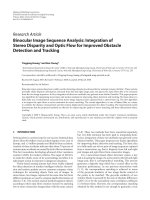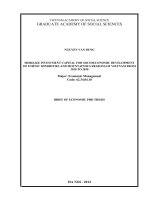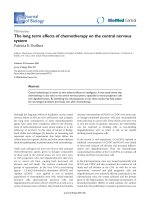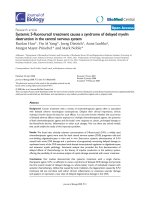Development of hybrid promoters and viral vectors for improved gene delivery to the central nervous system
Bạn đang xem bản rút gọn của tài liệu. Xem và tải ngay bản đầy đủ của tài liệu tại đây (3.29 MB, 138 trang )
DEVELOPMENT OF HYBRID PROMOTERS AND VIRAL
VECTORS FOR IMPROVING GENE DELIVERY TO THE
CENTRAL NERVOUS SYSTEM
WANG CHAOYANG
(B.Sc.; M.Sc.)
A THESIS SUBMITTED
FOR THE DEGREE OF DOCTOR OF PHILOSOPHY
DEPARTMENT OF ANATOMY
NATIONAL UNIVERSITY OF SINGAPORE
&
INSTITUTE OF BIOENGINEERING AND NANOTECHNOLOGY
2005
ACKNOWLEDGMENTS
My sincere thanks and appreciation go to my supervisor Dr Wang Shu, group
leader, Institute of Bioengineering and Nanotechnology, and Associate
Professor, Department of Biological Science, NUS, for his full support, untiring
guidance, stimulating discussions, and constant encouragement.
I also want to give my sincere thanks and appreciation to my co-supervisors,
Dr Ng Yee Kong and Dr Xiao Zhicheng, for their support and guidance.
Without their helps the thesis would not be done so smoothly.
My sincere gratitude go to Ms Guo Haiyan, Dr Wang Xu, Dr Liu Beihui, Mr
Gao Shujun, Ms Ma YueXia, and other members in the group of delivery of
drugs, proteins and genes, for their technical advice in laboratory techniques,
invaluable contributions to some aspects of this work and more importantly,
their friendship.
II
PUBLICATIONS
Journals
Wang CY, Wang S. Astrocytic expression of transgene in the rat brain
mediated by baculovirus vectors containing an astrocyte-specific promoter.
Gene Ther. In press.
Wang CY, Wang S. (2005) AAV inverted terminal repeats improve neuronal
transgene expression mediated by baculovirus vectors in the rat brain. Hum
Gene Ther. 16: 1219-1216.
Wang CY, Guo HY, Lim TM, Ng YK, Neo HP, Hwang PYK, Yee WC, Wang S.
(2005) Improved neuronal transgene expression from an AAV-2 vector with a
hybrid CMV enhancer/PDGF-b promoter. J Gene Med. 7: 945-955.
Wang X, Wang C, Zeng J, Xu X, Hwang PY, Yee WC, Ng YK, Wang S.
(2005) Gene transfer to dorsal root ganglia by intrathecal injection: effects on
regeneration of peripheral nerves. Mol Ther. 12: 314-320.
Li Y, Wang J, Lee CGL, Wang CY, Gao SJ, Tang GP, Ma YX, Yu H, Mao HQ,
Leong KW, Wang S. (2004) CNS gene transfer mediated by a novel
controlled release system based on DNA complexesof degradable polycation
PPE-EA: a comparison with polyethylenimine/DNA complexes. Gene Ther.
11: 109-114.
III
Xu G, Nie DY, Chen JT, Wang CY, Yu FG, Sun L, Luo XG, Ahmed S, David
S, Xiao ZC. (2004) Recombinant DNA vaccine encoding multiple domains
related to inhibition of neurite outgrowth: a potential strategy for axonal
regeneration. J Neurochem. 91: 1018–1023.
Nie DY, Zhou ZH, Ang BT, Teng FYH, Xu G, Xiang T, Wang CY, Zeng L,
Takeda Y, Xu TL, Ng YK, Faivre-Sarrailh C, Popko B, Ling EA, Schachner M,
Watanabe K, J. Pallen C, Tang BL, Xiao ZC. (2003) Nogo-A at CNS
paranodes is a ligand of Caspr: possible regulation of K+ channel localization.
EMBO J. 22: 5666-5678.
Patent
Wang S, Wang CY. “Method of using baculovirus vectors fro glioma therapy”,
PCT application pending, 2005.
Conference papers
Wang CY, Wang S. Retarget AAV Vectors to NGF Receptor Positive Cells.
The
First
International
SBE
Conference
on
Bioengineering
and
Nanotechnology. September 2004, Singapore.
Wang CY, Chen XL, Ng YK, Wang S, Xiao ZC. EGFL Domain of Tenasin-R is
Antiadhesive to Activated Microglial Cells. The First Asia Pacific Conference &
Exhibition on Anti-Aging Medicine. June 2002, Singapore.
IV
CONTENTS
PAGE
Acknowledgements
II
Publications
III
Table of contents
V
Summary
IX
List of figures
XI
Abbreviations
XIII
Chapter 1. Introduction
1
1.1 Current progress in gene therapy
3
1.2 Gene delivery to the CNS
4
1.3 Promoters used for gene delivery to the CNS
6
1.3.1 Promoters derived from viral genomes
7
1.3.2 Mammalian promoters
8
1.3.3 Hybrid promoters
10
1.3.4 Other DNA elements regulating the gene expression
11
1.4 Vectors used for gene delivery to the CNS
12
1.4.1 Non-viral vectors
13
1.4.2 Viral vectors
14
1.4.3 Hybrid viral vectors
17
1.5 Objectives of this study
19
V
Chapter 2. Hybrid Neuron-Specific Promoter
21
2.1 Introduction
22
2.2 Materials and methods
27
2.2.1 Plasmids for AAV-2 vectors
27
2.2.2 Production and titration of AAV-2 vectors
27
2.2.3 Generation of recombinant baculovirus vectors
29
2.2.4 In vitro transduction with viral vectors and
PEI/DNA complexes
31
2.2.5 In vivo transduction with viral vectors and
PEI/DNA complexes
33
2.2.6 Immunohistochemistry analysis
35
2.2.7 Southern blot analysis
36
2.2.8 Statistics
36
2.3 Results
37
2.3.1 In vitro and in vivo gene delivery with AAV-2 vectors
carrying the hybrid CMV E/PDGF promoter
37
2.3.1.1 Gene expression in cultured cells
37
2.3.1.2 Gene expression in the striatum
39
2.3.1.3 Gene expression in the substantia nigra
45
2.3.2 In vitro and in vivo gene delivery with baculovirus vectors
carrying the hybrid CMV E/PDGF promoter
48
2.3.2.1 Gene expression in cultured cells
48
2.3.2.2 Gene expression in the rat brain
52
2.4 Discussion
57
VI
Chapter 3. Hybrid Astrocyte-Specific Promoter
67
3.1 Introduction
68
3.2 Materials and methods
70
3.2.1 Construction of plasmids containing the hybrid
promoter
70
3.2.2 Construction of recombinant baculovirus vectors
71
3.2.3 Plasmid transfection and virus infection
73
3.2.4 Immunohistochemistry analysis
73
3.2.5 Luciferase assay
74
3.2.6 Statistics
74
3.3 Results
75
3.3.1 Improved transgene expression in cultured cells
using the hybrid CMV E/GFAP promoter
75
3.3.2 Astrocyte-specific transgene expression in the brain
80
3.3.3 Improved transgene expression in the brain
84
3.4 Discussion
87
Chapter 4. Hybrid Baculovirus-AAV Vector
91
4.1 Introduction
92
4.2 Materials and methods
94
4.2.1 Construction of hybrid baculovirus-AAV vectors
94
4.2.2 In vitro virus infection
96
4.2.3 Luciferase assay
97
4.2.4 Nested PCR
97
VII
4.3 Results
4.3.1 In vitro transgene expression from hybrid viral vectors
98
98
4.3.2 Site-specific integration mediated by hybrid
baculovirus-AAV vectors in human-originated cells
102
4.4 Discussion
104
Chapter 5. Conclusion
109
Chapter 6. References
112
VIII
SUMMARY
Gene therapy is a promising approach for the treatment of neurological
disorders in the central nervous system (CNS). Because of the complex
structure and high vulnerability of the CNS, it is critical that the expression of a
therapeutic gene is restricted within the target regions or cells, and the level
and duration of the expression can be regulated as desired. With currently
available promoters and gene delivery vectors, it remains a great challenge to
temporally and spatially control the transgene expression in the CNS. The
purpose of this study was to develop novel promoters that can drive high level
and neuron- or glia-specific transgene expression in the CNS, and to test or
modify viral vectors suitable to harbor these promoters. The ultimate objective
of the study is to use these promoters and vectors for gene therapy of
neurological disorders, particularly Parkinson’s disease (PD) and gliomas.
In the first part of this study, a hybrid promoter constructed by fusing the
enhancer of human cytomegalovirus immediate-early gene (CMV E) to the
promoter of human platelet-derived growth factor B-chain (PDGF), namely
CMV E/PDGF promoter, was tested in the context of Adeno-associated
viruses type 2 (AAV-2) and baculovirus vectors to drive in vitro and in vivo
transgene expression. A high level, neuron-specific and long-term transgene
expression was achieved in rat striatum and substantia nigra with the AAV-2
vectors, while a high level and neuron-specific, but only transient expression
was observed with the baculovirus vectors. In addition, the baculovirusmediated neuron-specific expression was improved with the introduction of
IX
inverted terminal repeats (ITRs) of AAV by flanking the expression cassette in
baculovirus vectors.
Secondly, a hybrid astrocyte-specific promoter with high transcriptional
activity, namely CMV E/GFAP promoter, was constructed by adding the CMV
enhancer to the upstream of human glial fibrillary acidic protein (GFAP)
promoter. In vitro and in vivo gene transfer showed that a high level and
astrocyte-specific, but transient gene expression could be achieved with
baculovirus vectors carrying the CMV E/GFAP promoter. ITRs could improve
the baculovirus-mediated astrocyte-specific transgene expression as well.
Thirdly,
a
hybrid
baculovirus-AAV
viral
vector
was
constructed
by
incorporating the two key elements of AAV, the ITRs and the Rep gene, into
the backbone of baculovirus. Promoters constructed in first two parts of this
study were incorporated into this hybrid viral vector. Gene transfer
experiments confirmed its capacity of mediating a stable transgene
expression in human-originated cells by site-specific integration of the
transgene into the host chromosome 19.
In conclusion, the novel hybrid promoters constructed in this study displayed
high and cell type-specific transcriptional activities, and suitable for neuron- or
astrocyte-specific gene delivery to the CNS. By using AAV-2 vectors,
baculovirus vectors with ITRs or hybrid baculovirus-AAV vectors, these
promoters could be potentially applied for gene therapy for neurodegenerative
diseases and possibly for malignant glioma tumors in the CNS.
X
LIST OF FIGURES
Fig. 2.1 Schematics of the expression cassettes of the recombinant AAV
vectors used in this study.
Fig. 2.2 Schematics of the expression cassettes of the recombinant
baculovirus vectors used in this study.
Fig. 2.3 Luciferase activity in primary cells and cell lines infected by AAV-2
vectors with different promoters.
Fig. 2.4 Neuron-specificity of luciferase expression mediated by AAV-CMV
E/PDGF in the rat striatum.
Fig. 2.5 Dose-dependent gene expression in the rat striatum using AAV-2
vectors
Fig. 2.6 Time courses of luciferase expression in the rat striatum after
injection of AAV-2 vectors or PEI/pDNA complexes.
Fig. 2.7 Luciferase expressions in the rat substantia nigra after injection of
AAV-2 vectors into striatum or substantia nigra.
Fig. 2.8 Neuron-specificity of luciferase expression mediated by AAV-CMV
E/PDGF in the rat substantia nigra.
Fig. 2.9 Dynamics of luciferase expression in cultured cells infected with
recombinant baculoviruses.
Fig. 2.10 Southern blot analysis of NT-2 cells infected with BV-CMV E/PDGFITR.
Fig. 2.11 Dynamics of luciferase expression in the rat brain after single
injection of recombinant baculoviruses.
Fig. 2.12 Activity of CMV E/PDGF promoter in cortical neurons after injection
of baculovirus vectors into the striatum.
Fig. 2.13 Immunohistological analysis of rat brains injected with recombinant
baculoviruses.
Fig. 3.1 Schematics of the expression cassettes of the recombinant pGL3
plasmids used in this study.
Fig. 3.2 Schematics of the expression cassettes of the recombinant
baculovirus vectors used in this study.
Fig. 3.3 Luciferase activity in primary glial cells and astrocytoma cells
transfected with plasmids carrying four different promoters.
XI
Fig. 3.4 Baculovirus-mediated transduction in cultured glial cells.
Fig. 3.5 Time courses of luciferase expression in glioma cell lines infected
with recombinant baculoviruses.
Fig. 3.6 Immunohistological analysis of rat brains injected with recombinant
baculoviruses.
Fig. 3.7 Activity of CMV E/GFAP promoter in neurons as measured by
luciferase expression in a brain region remote from an injection site.
Fig. 3.8 Baculovirus-mediated transduction in the brain.
Fig. 4.1 Expression cassettes of the recombinant baculovirus and hybrid
baculovirus-AAV vectors used in this study.
Fig. 4.2 Transgene expressions in neuronal cells HCN-2 (top) and PC12
(bottom) mediated by hybrid baculovirus-AAV vectors containing CMV
E/PDGF promoter.
Fig. 4.3 Transgene expressions in a human glioma cell line U251 (top) and a
rat glioma cell line C6 (bottom) after the infection of hybrid baculovirus-AAV
vectors containing CMV E/GFAP promoter.
Fig. 4.4 Site-specific integration mediated by hybrid baculovirus-AAV vectors.
XII
ABBREVIATIONS
AAV
Adeno-associated virus
ABP
Alpha1-microglobulin/bikunin
AD
Alzheimer’s disease
ADH6
Alcohol dehydrogenase 6
ApoE
Apolipoprotein E
BBB
Blood brain barrier
BDNF
Brain-derived neurotrophic factor
BV
Baculovirus
CAG
CMV enhancer/β-actin promoter
CMV
Cytomegalovirus
CMV E
Enhancer of cytomegalovirus immediate-early gene
CNS
Central nervous system
DMEM
Dulbecco’s modified eagle’s medium
EF1α
Elongation factor 1 α
ELISA
Enzyme linked immunosorbent assay
FBS
Fetal bovine serum
FGF-R1
Fibroblast growth factor receptor 1
GBM
Glioblastoma multiforme
GDNF
Glial cell-line derived neurotrophic factor
GFAP
Glial fibrillary acidic protein
hAAT
Human alpha-antitrypsin
hr
Hour
HSPGs
Heparan sulfate proteoglycans
HSV
Herpes simplex virus
XIII
ITR
Inverted terminal repeats
LTR
Long terminal repeats
Luc
Luciferase
MBP
Myelin basic protein
MCS
Multiple cloning site
min
Minute
MOI
Multiplicity of infection
NeuN
Neuron-specific nuclear protein
NGF
Nerve growth factor
NSE
Neuron-specific enolase
NT-3
Neurotrophin 3
6-OHDA
6-hydroxydopamine
OTC
Ornithine transcarbamylase
PBS
Phosphate-buffered saline
PD
Parkinson’s disease
PDGF
Platelet derived growth factor
PEI
Polyethyleneimine
pfu
Plaque-forming units
RLU
Relative light unit
RSV
Rous sarcoma virus
sec
Second
S.D.
Standard deviation
SV40
Simian virus 40
TH
Tyrosine hydroxylase
WPRE
Woodchuck posttranscriptional regulatory element
XIV
Chapter 1. Introduction
Chapter one
Introduction
1
Chapter 1. Introduction
Gene therapy, which can be defined as a correction or prevention of a
disease by the use of genetic materials, has been regarded as a potential tool
for many presently untreatable or poorly managed diseases, including both
inherited and acquired diseases (Factor, 2001). Many neurological disorders
in the central nervous system (CNS), such as the neurodegenerative diseases
and malignant glioma tumors, are potentially amenable to gene therapy. Gene
delivery to the CNS has been extensively studied in the last decade, with a
variety of vectors, promoters and therapeutic genes, but limited progress has
been achieved as compared to gene delivery to other organs, reflected by the
small number of clinical trials on gene therapy of CNS diseases (Lowenstein
and Castro, 2002). Greater challenges remain for gene delivery to the CNS
than other organs because of the unique characters of the CNS, such as
limited access, complex structure and high risk, etc (Hsich et al., 2002).
The core issue and also a huge challenge for gene therapy of CNS disorders
is to build up a safe and efficient delivery system to temporally and spatially
control the expression of the therapeutic gene as desired. The promoter and
vector are the two essential elements in a gene delivery system, controlling
the level, specificity
and
duration of transgene
expression at
the
transcriptional and the transductional level respectively. For gene therapy of
neurological diseases in the CNS, it is important that a particular promoter
and vector should be carefully selected, combined, and sometimes properly
modified for the treatment of a particular condition. In this introduction, the
current progress in gene therapy of some neurological disorders in the CNS
2
Chapter 1. Introduction
will be discussed, followed by overview of the progress made by using
different types of promoters and vectors for gene delivery to the CNS.
1.1 Current progress in gene therapy
Gene therapy, which usually refers to somatic gene therapy, can be broadly
defined as the treatment of a disease through the addition and expression of
genetic materials that reconstitute or correct missing or aberrant genetic
functions or interfere with disease-causing processes. The targets of gene
therapy have been broaden from monogenetic diseases to multigenetic
diseases, and further to acquired diseases (Factor, 2001). Three essential
components are involved in gene therapy: a therapeutic gene, a regulatory
element, usually a promoter, and a delivery vehicle, also named a vector
(Russell, 1997).
The therapeutic gene is selected according to the target disease. Originally, it
was proposed to use the therapeutic gene for replacing the mutant gene.
However, the replacement approach is complicated and remains difficult.
More commonly and practically, the therapeutic gene is used to ameliorate
diseases, either inherited or acquired, by enhancing, reducing or altering a
particular gene expression in the target cells (Mountain, 2000). The promoter
is one of the key issues of gene therapy. The expression level and specificity
of the therapeutic gene is primarily determined by the activity of the promoter
at the transcriptional level, and the duration of the transgene expression can
also be influenced by the selection of promoters. The gene delivery vector
that carries and transfers the gene into the nuclei of target cell is another key
3
Chapter 1. Introduction
issue of gene therapy. The tropism of the vector can essentially determine the
cell type-specificity of the transgene expression at the transductional level,
and the transduction efficiency of the vector will strongly affect the expression
level. More importantly, the status of the transferred gene, integrated or
episomal, will decide the duration of the transgene expression, which might be
transient or long-term.
More than a decade has been elapsed since the first clinical trial of gene
therapy, and it is becoming increasingly clear that it is almost impossible to
create an universal gene delivery system for the treatment of all diseases, or
even for several similar diseases, since each disease has its specific
requirements for the expression pattern of the therapeutic gene, and special
technical obstacles to be overcome (Rubanyi, 2001). The various elements of
a gene delivery system, especially the promoter and the vector, need to be
optimized and combined specially for each particular application.
1.2 Gene delivery to the CNS
Gene delivery to the CNS, especially the brain, is drawing more and more
attention recently. Many diseases occurring in the CNS, especially
neurodegenerative disorders like Parkinson’s disease (PD) and malignant
glioma tumors, are potentially amenable to gene therapy. Conventional
treatments to these diseases such as surgery and invasive drug delivery,
might cause big damage to the brain as repetitive operation is usually
required, e.g. to remove recurrent brain tumors, or to inject drugs with short
half-life. Gene therapy, on the other hand, can minimize this kind of damage
4
Chapter 1. Introduction
to the brain by a single delivery of genetic materials that might mediate a
sustained and high-level expression of therapeutic gene.
PD is a common neurodegenerative condition characterized by the
degeneration of nigrostriatal dopaminergic neurons, with symptoms of rigidity,
tremor, bradykinesia, and postural imbalance (Shastry, 2000). Unlike other
neurodegenerative disorders such as Alzheimer’s disease (AD) that globally
affect the nervous system and involves many types of cells, PD is confined
primarily to a well-defined, compact group of neurons. Moreover, a variety of
well-defined animal models have long been available by using neurotoxins
such as 6-hydroxydopamine (6-OHDA), bringing PD to the forefront in studies
of gene therapy for neurodegenerative diseases. Gene delivery of
neurotrophic factors, mainly glial cell-line derived neurotrophic factor (GDNF),
by viral vectors such as adenovirus, lentivirus and adeno-associated virus
(AAV) vectors, to diseased dopamine neurons or astrocytes surrounding the
neurons in the target area could prevent degeneration of dopamine neurons
and rescue motor deficits (Raymon et al., 1997; Kordower et al., 2000; Sun et
al., 2005). Direct gene delivery of the tyrosine hydroxylase (TH) that is
responsible for the biosynthesis of L-Dopa from tyrosine in the striatum has
also shown significant transgene expression (During et al., 1994). The major
challenge for gene therapy of PD is to develop a safe vector that can provide
high level of long-term transgene expression specifically in the target cells,
neurons or astrocytes, in the affected area of the CNS.
5
Chapter 1. Introduction
Malignant glial tumors, also named glioblastoma multiforme (GBM) that
originate from astrocytes, are the most common primary brain tumors in
adults. Currently, GBM is almost incurable. Even with surgery, radiation, and
chemotherapy, patients with GBM usually die within about a year, with few
patients survive longer than 3 years. Specific delivery of therapeutic genes by
viral vectors to malignant gliomas has proven to be a promising novel
treatment (Sandmair et al., 2000; Smith and Chiocca, 2000). The difficulty for
gene therapy of glioma tumors is how to restrict the delivered therapeutic
gene within the tumor cells, since the expression of the therapeutic genes in
normal cells will cause severe side effects and even cell death.
Gene delivery to the brain, an organ so complex and critical to human
integrity, raises some special issues like safety and risk-benefit ratio (Hsich et
al., 2002). Furthermore, the limited access to the CNS due to the skull and the
blood brain barrier (BBB), the complex structure with numerous functional
domains and circuitries, and the great diversity of the cell types in the CNS
greatly increase the difficulty of gene delivery. In sight of these considerations,
special attention has to be paid to the gene delivery system, especially to the
safety issue which is related to the vector and the temporal and spatial control
of the transgene expression. In the following sections, some currently used
promoters and viral vectors for gene delivery to the CNS will be discussed.
1.3 Promoters used for gene delivery to the CNS
Numerous promoters have been employed to control the transgene
expression in the CNS, including viral-based promoters, mammalian
6
Chapter 1. Introduction
promoters and some composite promoters, also named hybrid promoters.
Some other DNA regulatory elements, such as the posttranscriptional
regulatory element of woodchuck hepatitis virus (WPRE) and inverted
terminal repeats (ITRs) of AAV, were also used alongside with the promoters
to regulate the transgene expression. By using an appropriate promoter and
proper DNA regulatory elements, the expression level, specificity and duration
can be regulated as desired at the transcriptional level.
1.3.1 Promoters derived from viral genomes
Viral promoters have been widely employed for gene delivery to the CNS
during the early times of gene therapy. The mostly used viral-based promoter,
the promoter of cytomegalovirus (CMV) immediate-early genes, has been
demonstrated to drive strong transgene expression in the brain, and was used
for gene delivery to the CNS (Schmidt et al., 1990; Wilkinson and Akrigg,
1992; Kaplitt et al., 1994; McCown et al., 1996). Other viral-based promoters
used for CNS gene delivery include the simian virus 40 (SV40) promoter and
viral long terminal repeat (LTR) promoter from Rous sarcoma virus (RSV),
retrovirus and Moloney murine leukemia virus (Takekoshi et al., 1991; Mandel
et al., 1999; Shimazaki et al., 2000).
Although a high level of transgene expression can be achieved with these
viral-based promoters, such viral transcriptional elements are usually nonspecific, being active in a wide variety of cell types. Using viral-based
promoters for gene delivery to the CNS will lead to side effects like expression
of the therapeutic gene in nontarget cells, which may prove pathological,
7
Chapter 1. Introduction
causing severe damage to the brain. Another disadvantage associated with
viral-based promoters is the inactivation of the promoters in mammalian cells,
which might be mainly due to the methylation of viral DNA in mammalian cells
(Prosch et al., 1996). Such inactivation is indicated with the gradual decline of
the transgene expression driven by viral promoters. Depending on the vector
system, gene expression driven by CMV promoter can be maintained at a
relatively high level for various durations, from days to months, and drop
rapidly after that due to the inactivation (Prosch et al., 1996; Brooks et al.,
2004; Everett et al., 2004). The short-term expression driven by viral-based
promoter limits their application for gene therapy of neurological disorders in
the CNS, especially neurodegenerative diseases like PD, which require a
long-term expression of the therapeutic gene.
1.3.2 Mammalian promoters
As compared to viral promoters, mammalian promoters can restrict the
transgene expression within the target cells, therefore minimizing the side
effects caused by unintended transduction. Moreover, mammalian promoters
may be less likely to activate host cell defense machinery because of their
authentic sequences, thus are usually less sensitive to cytokine-induced
promoter inactivation than viral promoters (Dressel et al., 2000). Therefore, a
cell type-specific and more stable transgene expression usually can be
achieved with a mammalian promoter than with a viral promoter. Two kinds of
mammalian promoters, which can drive specific transgene expression in
neurons and glial cells respectively, were commonly used for gene delivery to
the CNS.
8
Chapter 1. Introduction
Neuron-specific promoters, such as the promoter of neuron-specific enolase
(NSE) and the promoter of human platelet-derived growth factor B chain
(PDGF), have been used to drive neuron-specific transgene expression in the
brain. NSE promoter was first shown to drive a high level of neuronally
restricted lacZ expression in a transgenic mouse study (Forss-Petter et al.,
1990). It was also found to facilitate a very high level of AAV-mediated
transgene expression in the CNS (Peel et al., 1997). Another widely used
neuron-specific promoter is the human PDGF promoter, which was shown to
specifically target transgene expression to neurons in transgenic mouse
studies (Masliah et al., 2000). AAV vector with the PDGF promoter has been
shown to drive transgene expression at the rat substantia nigra for at least 1
month postinjection (Furler et al., 2001).
The promoter of myelin basic protein (MBP) and the promoter of glial fibrillary
acidic protein (GFAP) are two promoters that have been employed to drive
glia-specific transgene expression in the CNS. BMP promoter was
demonstrated to direct expression specifically to oligodendrocytes (Gow et al.,
1992), while GFAP promoter was described as an astrocyte-specific promoter
(Brenner et al., 1994). GFAP promoter was also widely used for specific gene
delivery to malignant gliomas that originated from astrocytes (Vandier et al.,
2000).
Although these neuron- or glia-specific promoters can drive cell type-specific
and
sometime
sustained
transgene
expression
in
the
CNS,
their
9
Chapter 1. Introduction
transcriptional activities are relatively low as compared to a viral promoter like
CMV promoter. Under the control of those mammalian promoters, transgene
expression is usually maintained at the physiological level, which might be not
high enough to achieve significant therapeutic effects for the chronic
neurological diseases and glioma tumors.
1.3.2 Hybrid promoters
The relatively low transcriptional activity of mammalian promoter has led to
significant research efforts to improve their strength for applications where
high level and cell type-specific gene expression are required (Iyer et al.,
2001; Wang et al., 2003; Ionescu et al., 2004). One approach successfully
applied to several mammalian promoters is appending a viral transcriptional
regulatory element to a mammalian promoter to create a composite, also
called hybrid promoter (Nettelbeck et al., 1998). SV40 enhancer and CMV
enhancer, both are strong viral regulatory elements of quite small sizes, which
are most commonly used to fuse with mammalian promoters with weak
transcriptional activities (Niwa et al., 1991; Sawicki et al., 1998). Compared to
the original mammalian promoter, the hybrid promoter can usually drive
transgene expression at high levels and sometime with retained cell type
specificity.
The CMV enhancer/beta-actin (CAG) promoter is a widely used hybrid
promoter that is composed of the CMV enhancer fused to the chicken 3/4
actin promoter. CAG promoter has been shown to have a higher activity in
most tissues, as compared to the CMV promoter or beta-actin promoter (Yew
10
Chapter 1. Introduction
et al., 2001). An AAV vector carrying a CAG promoter could drive a 137-fold
higher expression of human factor X than the CMV promoter in the liver of
mice (Xu et al., 2001a). Hybrid promoters for improved liver specific transgene
expression were also developed. Hepatocyte-specific enhancers like the
alpha1-microglobulin/bikunin (ABP) enhancer and apolipoprotein E (apoE)
enhancer were linked with core promoters like alcohol dehydrogenase 6
(ADH6) promoter and human alpha-antitrypsin (hAAT) promoter to construct a
variety of hybrid promoters, among which the apoE enhancer/ADH6 promoter
could drive a highly efficient and specific transgene expression in liver cells
(Gehrke et al., 2003).
A hybrid neuron-specific promoter, namely CMV E/PDGF promoter, was
previously constructed by combining the CMV enhancer with the human
PDGF promoter (Liu et al., 2004). When used with a polyethyleneimine (PEI)
/DNA delivery system, this promoter can drive in vivo expression of a
luciferase reporter gene at high level while preserving neuronal specificity.
However, the transgene expression driven by this hybrid CMV E/PDGF
promoter in viral vectors has not been assessed yet. Using this strategy might
also hopefully improve the relatively low transcriptional activity of the GFAP
promoter, thus propelling its application for high level astrocyte-specific gene
delivery to the CNS.
1.3.4 Other DNA elements regulating the gene expression
Besides the promoters, some other DNA elements are also used to regulate
the transgene expression in mammalian cells. WPRE is one of the DNA
11


